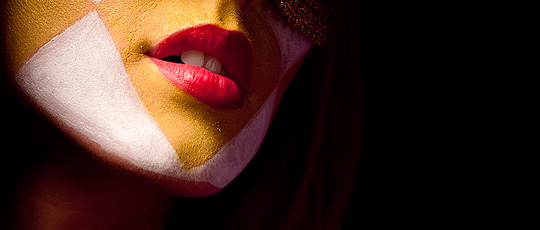


[...] A charming double portrait of Marcela Pavia and Max E. Keller leaves with all the variety of their writing appear some similarities, especially since the pieces are part performed by the same performer. A tendency toward abstraction, the rhythmic obstinacy and hard contours of musical processes is common to both, the Argentinean somewhat spontaneously operates as the more intellectually controlled Swiss. Both can also shine through a penchant for Fantastic - she with dynamic charge he with selected timbres and spatial effects, such as the orchestral piece "tenuto, battuto, brilliant." [...]
-Max Nyffeler
original language below...
[...]Ein reizvolles Doppelporträt von Marcela Pavia und Max E. Keller lässt bei aller Verschiedenheit ihrer Schreibweisen einige Ähnlichkeiten aufscheinen, zumal die Stücke teilweise von den gleichen Interpreten gespielt werden. Ein Hang zur Abstraktion, zur rhythmischen Widerborstigkeit und harten Konturierung der musikalischen Verläufe ist Beiden gemeinsam, wobei die Argentinierin etwas spontaner operiert als der eher intellektuell gesteuerte Schweizer. Beide lassen auch einen Hang zum Fantastischen durchschimmern - sie mit dynamischer Aufladung, er mit ausgesuchten Klangfarben und Raumwirkungen, wie etwa im Orchesterstück „tenuto, battuto,fulminante".[...]

This double portrait connects two composers who initially have little in common : Marcela Pavia ( * 1957 in Rosario ) has in Argentina, later studied in Italy Composition and now lives in Milan,the Swiss Max E. Keller (* 1947 in Aarau ) profiled next to the study early as an improvising musician. They met at a cultural exchange project between Switzerland and Argentina - and both have written for the trio flair a new plant . For all the differences and similarities are discovering about references to the folk tradition of the respective countries . In addition, Marcela Pavia is committed to a youthful penchant for rock à la Jethro Tull and that of Max E. Keller always shines through free-jazz experience. And both provide taboos of avant-garde in question: the pulse , the rhythm - they are felt as a unifying element in this double portrait with works from 2001 to 2009. Nevertheless - the differences predominate.
Marcela Pavia, wrote mainly chamber music. The root is rhythmic , powerful, rich in tone color and extra-musical connotations. Nayla for solo flute (1993 ), the only older composition of the CD , hurtling past with soloist Lisa Cella like a irrlichterndes Presto Furioso .
Occupations with guitar dominate , such Amancay , named after a Patagonian flower - here fall into the incisive play by Matt Gould ( guitar) and Gleb Kanasevich ( clarinet)
alongside folklore impressions also rock , percussive passages on "The Banshee 's Keen" for solo guitar refers to an Irish fairies suit - very dark and mystical music played by Patrik Kleemola . Per un addio for speaker and piano on a poem by Gabriela Fantato recalls the massacre of fascist troops in April 1944, the Resistance fighters in Cascina Benedicta (Piedmont ), a reference that does not mention the booklet - Esther Flückiger sensed at the piano a wild impetuous pain that settles in mild tones . Conceptually rather abstract goes Max E. Keller to work . The only orchestral work of the CD , Tenuto , battuto , fulminant , a live recording of the premiere in 2003 with the Tonhalle Orchester Zurich under David Zinman , exposed three gestural elements : the sustained note , the beat and the flash. Sounds, rhythms and spotlights penetrate each other - a drama with Blechgedröhn and drum thunder. While varying in Trio fluido a Swiss Landler motif, diving in Cinque Fagottquartett on jazzy phrases. Sensual action unfold interpreted by Werner Baertschi soliloquy for piano and live electronics - echoes , distorted reflections and tinny reverb effects evoke a ghostly atmosphere. Conclusion: A double portrait of two composers, who have kept a certain distance from common spellings and yet articulate decidedly contemporary.
- Otto Paul Burkhardt
original review below...
Dieses Doppelporträt verbindet zwei Komponisten, die zunächst wenig Gemeinsames haben: Marcela Pavia (*1957 in Rosario) hat in Argentinien, später in Italien Komposition studiert und lebt heute in Mailand, der Schweizer Max E. Keller (*1947 in Aarau) profilierte sich neben dem Studium früh als improvisierender Musiker. Kennen gelernt haben sie sich bei einem kulturellen Austauschprojekt zwischen der Schweiz und Argentinien – und beide haben für das Trio Flair ein neues Werk geschrieben. Bei aller Unterschiedlichkeit sind auch Gemeinsamkeiten zu entdecken, etwa Bezüge zur folkloristischen Tradition der jeweiligen Länder. Hinzu kommt, dass Marcela Pavia sich zu einem Jugend-Faible für Rock à la Jethro Tull bekennt und dass bei Max E. Keller immer wieder Free-Jazz-Erfahrung durchscheint. Und beide stellen Tabus der Avantgarde in Frage: Der Puls, der Rhythmus – sie sind als verbindendes Element in diesem Doppelporträt mit Werken von 2001 bis 2009 spürbar.
Dennoch – die Unterschiede überwiegen. Marcela Pavia schreibt vorwiegend Kammermusik. Der Grundton ist rhythmisch, kraftvoll, reich an Klangfarben und außermusikalischen Konnotationen. Nayla für Flöte solo (1993), die einzige ältere Komposition der CD, rast mit der Solistin Lisa Cella wie ein irrlichterndes Presto-Furioso vorüber. Besetzungen mit Gitarre dominieren, etwa Amancay, benannt nach einer patagonischen Blume – hier fallen in der prägnanten Wiedergabe durch Matt Gould (Gitarre) und Gleb Kanasevich (Klarinette) neben Folklore-Anmutungen auch rockige, perkussive Passagen auf. The Banshee’s Keen für Gitarre solo bezieht sich auf eine irische Feen-Klage – sehr düster und mystisch musiziert von Patrik Kleemola. Per un addio für Sprecher und Klavier nach einem Gedicht von Gabriela Fantato erinnert an das Massaker faschistischer Truppen im April 1944 an Resistenza-Kämpfern in Cascina Benedicta (Piemont), ein Bezug, den das Booklet nicht erwähnt – Esther Flückiger erspürt am Piano einen wild aufbrausenden Schmerz, der sich in milden Klangfarben beruhigt.
Konzeptionell eher abstrakt geht Max E. Keller zu Werke. Das einzige Orchesterwerk der CD, Tenuto, battuto, fulminante, ein Live-Mitschnitt der Uraufführung 2003 mit dem Tonhalle Orchester Zürich unter David Zinman, exponiert drei gestische Elemente: den Halteton, den Schlag und den Blitz. Klänge, Rhythmen und Schlaglichter durchdringen sich – ein Drama mit Blechgedröhn und Trommeldonner. Während in Trio fluido ein Schweizer Ländlermotiv variiert wird, tauchen im Fagottquartett Cinque jazzige Phrasen auf. Sinnliche Wirkung entfalten die von Werner Bärtschi interpretierten Selbstgespräche für Klavier und Live-Elektronik – Echos, verzerrte Spiegelungen und blecherne Halleffekte evozieren eine geisterhafte Atmosphäre.
Fazit: Ein Doppelporträt zweier Komponisten, die sich eine gewisse Distanz zu gängigen Schreibweisen bewahrt haben und sich dennoch dezidiert zeitgenössisch artikulieren.

"Aires de Sefarad (2004) are 46 “Airs from (Sephardic) Spain” for violin and guitar taken from melodies sung in Ladino or Hebrew by Spanish Sephardic Jews in the 14th Century. These songs were taken from Isaac Levy’s collection Chants Judeo-Espagnols and arranged as violin and guitar duets by Spanish composer and Berkeley professor Jorge Liderman, who has been on quite a roll of excellence lately (see his wonderful two piano Wind-Up Toys, last issue).
These little gems clock in at a minute or two a piece. There is plenty of melodic variety in these atmospheric modal masterpieces, and Mr. Liderman rises to the considerable challenge by providing endlessly inspired accompaniments and orchestrations. I was delighted every minute. These two brilliant musicians, violinist Beth Ilana Schneider and guitarist Matt Gould, are breathtaking in their virtuosic command and sublime musicality. If you enjoy sets like Falla’s Seven Spanish Folk Songs, you must hear these. And even if that’s not your usual cup of chocolate, you should definitely hear these anyway. A delight - highly recommended."
- Allen Gimbel, ARG Juy/August 2006 ARG

The label Neos launched , presenting the important Donaueschingen Festival , a new CD of contemporary music, composers MARCELA Pavia and MAX KELLER , which brings together two artists create a non-trivial combination , alternating between contrasts and meeting points. From Switzerland ( Max Keller) Argentina - Italy ( Marcela Pavia): all music and art , form a composite picture of the organic / different styles and talented performers from all over the world. Pulsating rhythms and smooth tonal masses are elements that change depending on the context that will " illuminate " (Max Keller ), and yet the use of sound plots treated like sounds complex , fast-paced but asynchronous , Resonance with poetic meanings and timbre. Marcela Pavia): this is the picture of style that takes shape through orchestral or chamber ensembles different for each brano.A corollary of the colorful painting , no less a colorful array of performers from Europe ( Trio Flair , Tonhalle Orchestra Zurich , Quadriga Bassoon Ensemble, W. Bartschi , Esther Gloor Flueckiger and Valentin , Patrik Kleemola , Gleb Kassenevich ) America ( Duo 46 Lisa Cella , Matt Gould ). The point of decisive meeting between the two composers , is undoubtedly by Esther Flueckiger and Trio Flair who have commissioned Marcela Pavia and the two Max Keller Trio ( Trio Flair and fluid ) that are the centerpiece of the CD and the tour made in 2009 and 2010 in Italy , Argentina and Switzerland.
